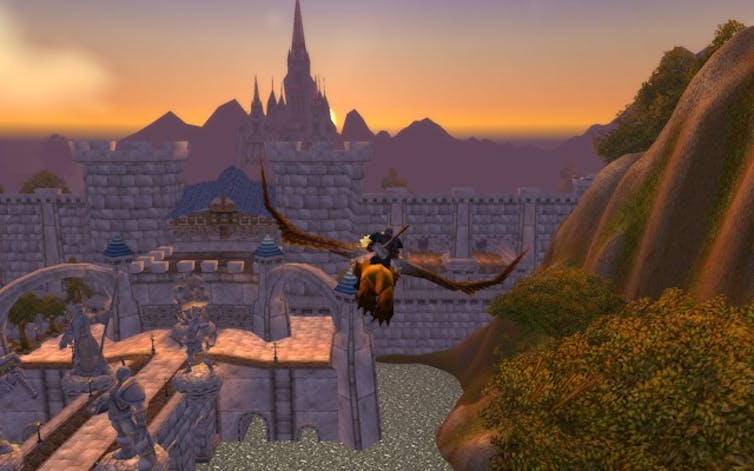26.2.23
Jankel Adler's Sketchbooks – 'His life was one long journey' | Tate
View on YouTube
22.2.23
CALVIN Z. LAING | ART & AWKWARDNESS
View on YouTube
14.2.23
How to cope when you lose access to a digital world you love
US games developer Blizzard Activision has become embroiled in worldwide litigation relating to its proposed acquisition by Microsoft. It has also fallen out with its Chinese distributor NetEase. This might sound like news for the business pages only. But it has had tangible, real-world consequences.
The developer’s flagship product is World of Warcraft, one of the most successful massively multiplayer online (MMO) games of all time. Across the globe, over 125 million players are estimated to have, at one time or other, come to call the land of Azeroth – the setting of the game – a home of sorts. As of late January 2023, however, the estimated three million people who play the game in China have lost all access to it.
Efforts are underway to restore access to the game for its Chinese fans.

This article is part of Quarter Life, a series about issues affecting those of us in our twenties and thirties. From the challenges of beginning a career and taking care of our mental health, to the excitement of starting a family, adopting a pet or just making friends as an adult. The articles in this series explore the questions and bring answers as we navigate this turbulent period of life.
You may be interested in:
Spotify Wrapped: how sharing your music tastes can drive feelings of Fomo
TikTok ‘mascara’ trend: young people have used codes to talk about sex for generations
Black Panther 2: why the death of someone young can be harder to handle
Being shut out of a virtual universe is not the same as physical eviction or forced migration. So, for some, this may seem a trivial event. To paraphrase Boris Becker, “we lost a game, not a war. Nobody died”. But when we enter a digital world, particularly a perpetual MMO, like World of Warcraft, which continues to exist when we disconnect, we are effectively migrating. Losing that world – one that has become a home – has immediate and important psychological effects.

The porous membrane
The migration between the physical and the virtual realms is usually relatively brief and easy to reverse. It involves crossing what virtual economies scholar Edward Castronova calls a “porous membrane”, which refers to a partial barrier between the physical and the virtual. Some things can cross in both directions (memories, values, attitudes, currency). Others (physical objects and characteristics in one direction, pet dragons and magical swords in the other) are blocked.
As players, we shift between the avatar we become in the virtual world and the person we are in everyday life. Research shows that people often choose avatars that are idealised versions of themselves (leaner, prettier, more muscular). We are not characters in these worlds but projections of our selves. The experiences we have and the actions we take are very much our own. Consequently our virtual life is likely to affect our physical life, on the other side of the membrane.
Digital worlds are not simply places where we kill monsters and acquire loot (although that part is fun). They are spaces where we socialise, work and enjoy spending time. In 2018, I conducted a study with fellow psychologists Andrea Oskis, Jacqueline Meredith and Rebecca Gould, which looked at the attachments people form to places in the real and the digital world.
To measure attachment to places (as opposed to people), we assess four different factors: how special a place is; how it contributes to our sense of identity; the people who are associated with it; and our feelings of affection towards it. On average, the 740 adults from a variety of countries who responded to our survey reported this last factor – feelings of affection – as being stronger for digital places than for their physical homes.
Emotional investment
Even though places in gaming universes have no physical existence at all, they are capable of eliciting strong feelings. It follows that when a world, its people and places, is taken from you, the impact is significant.
Players of dying games – and there are many – have flocked to servers to celebrate the times they have spent there. One player reacted to the news that Sony was shutting down its fantasy-world Free Realms by encouraging their fellow gamers to be grateful they’d had the chance to play at all. “We still have a month,” they said, “so let’s spend it being happy.”
The final six minutes of Final Fantasy XIV – with a meteor called Dalamud obliterating the in-game land of Eorzea – have gone down as the “single most powerful MMO ending in gaming history”. People who took part remember it as “an emotional rollercoaster” and something “very real and personal”.
And on the day interstellar wargame Tabula Rasa was shut down in 2009, players were invited to join in a desperate (and doomed) battle. A swansong was composed especially for the event. The two sides (the Allied Free Sentient human force and the Bane alien force) mutually destructed. One player subsequently described the lag between their actions and what was happening on screen as “unbearable” because so many gamers had joined in.
We made slow progress and eventually cleared out all of the enemies and captured the control point. There we danced, and cheered, and cried until the servers went dark forever.
There will be those who counter that games are just games, they are not real, and online experiences are of little importance. At the same time, though, most people recognise the deep hurt and desperation that result from cyberbullying, stalking and online crime. In other words, we all acknowledge that what happens online doesn’t stay online. Why should feelings of belonging and friendship not be offered the same status as those of despair and intimidation when they happen online?
The emotional investment players express show that we have the same response to the loss of a digital world as to the loss of anything in the physical world to which we are emotionally attached. Gamers in China who are no longer able to enter Azeroth will doubtless be experiencing the five stages of grief – denial, anger, bargaining, depression, and acceptance – because these feelings are hardwired into us.
Loss of all kinds is unbearable and infuriating. We feel deep sadness. We want things we have loved to return to how they were. This is a healthy response to a negative event beyond our control. Dealing with it in relation to a virtual world is no different than in the physical world. Accept the loss, notice it and do not try and change it. Crucially, acknowledge that all things change.![]()
Mark Coulson, Associate Professor in Psychology, University of East Anglia
This article is republished from The Conversation under a Creative Commons license. Read the original article.
11.2.23
Art in Focus | Untitled by Etel Adnan | Tate
View on YouTube
6.2.23
Yasmin Jahan Nupur – 'Let me get you a nice cup of tea...' | Tate
View on YouTube
4.2.23
Nipple ban on Instagram and Facebook reveals how bizarre our attitude is towards different genders
Some women consign themselves to breastfeeding in public toilets to prevent their apparently sexually explosive nipples causing offence. On hot days, meanwhile, males of all ages, shapes and sizes, peel off their tops without a second thought.
For over a decade many social media platforms banned the exposure of female, but not male nipples. Tech CEOs say they fear unleashing torrents of pornographic imagery. These platforms do allow images of female nipples in some contexts such as breastfeeding and medical issues.
However, the oversight board of Meta, the parent company of Facebook and Instagram, recently instructed both platforms to re-examine their policy on nipple exposure. It also recommends that Meta change its Adult Nudity and Sexual Activity Community Standard so that it is governed by clear criteria that respect international human rights standards.
Some campaigners hailed the news as a breakthrough. But there are no guarantees about what action these companies will take. It will come down to whatever best protects their interests and possibly finances, which could mean less change than people are hoping for.

Meta’s announcement was triggered by the case of a trans non-binary US couple posing topless, (with their nipples covered), to increase awareness of trans health care issues and to raise money for “top” surgery. Facebook and Instagram’s algorithm categorised the post as “sexual solicitation” and removed it (although their post was reinstated after they appealed).
This couple’s case may have forced Meta into acting but it’s also an example of why it’s still too early to celebrate. Millions of images are uploaded onto Facebook and Instagram each day. Moderating the content to prevent their platforms from being used to distribute porn, indecent images of children and violence is difficult and expensive. Algorithms are a cheaper but less discerning solution than solely using people to evaluate content.
A long road to here
These platforms have therefore long resisted change in spite of movements such as Free the Nipple campaigning for women’s freedom of bodily expression and professionals protesting their right to upload artistic photographs of topless indigenous women or culturally important images.
Social media platforms have incredible influence over people’s attitudes and behaviour. They enable the glorification of ageless and unrealistic female beauty which contributes to body dysmorphia, disordered eating practices and increased uptake of cosmetic procedures. Notably, these sites have also struggled to prevent the spread of violent videos.

People have taken to superimposing stickers of male nipples over female nipples to get around social media censors. The sticker overlays circumvent the rules but do not change the mindset that perceives female nipples as sexualised body parts, appropriated by the male gaze. If Facebook and Instagram only revise their policies to allow photos of exposed nipples if they belong to trans and non-binary people, this would still encourage the continued sexual objectification of cisgender women’s breasts and nipples.
The history of nipple censorship
Across many western cultures, exposed female nipples are seen as taboo, indecent and sometimes even illegal. In contrast, men with muscular chests and six-packs and taut ornamental nipples adorn fashion magazines, advertise products and are emblazoned across billboards. These practices are not always viewed as sexualised despite the fact many adverts are produced with this aim.
This also brings us back to the question as to whether female nipples are inevitably erotic. Some commentators claim men are hardwired to concentrate their erotic gaze on specific female body parts such as breasts. However, people’s beliefs about what constitutes an erotic body part has changed across history and cultures.
Both religion and cultural standards play a pivotal role in what is acceptable. Bare chests for both sexes were the norm in warm climates until the 12th century when Islam became more influential. Aboriginal topless culture was also commonplace in Australia until 2004 when police officers told a group of topless Aboriginal women performing a traditional dance that they had to cover up.
In previous time periods in England, the leg and the calves were regarded as more risqué than the nipples. In contrast in China the traditional practice of binding women’s feet to make them smaller, and thereby crippling them, was entwined with misogynistic eroticism.
On the other hand, European paintings from the Middle Ages to about the 1700s regularly featured women exposing one breast and nipple. In fact women often adorned their nipples with reddish-orange makeup from their dressing tables during this era. During this time “nipslips”, whether accidental or not, didn’t create outrage or taboo or signal the sexual availability of the woman involved. Compare this to Daily Mail article about a “photo exclusive” of supermodel Naomi Campbell accidentally exposing a nipple, which the newspaper ironically then censored in their article.
Up until 1936 in the US, men were also prohibited from exposing their nipples. Nudity for either sex was regarded as obscene until a mass male protest overturned this rule.
The debate around the exposure of female nipples in public or on social media suggests their sexualisation is a cultural phenomenon through which men control women’s bodies and feel entitled to make degrading comments about them.
Lorraine Green, Senior Lecturer in Social Sciences, Edge Hill University
This article is republished from The Conversation under a Creative Commons license. Read the original article.
"Art should be for everyone" – Mari Katayama | Tate
Artist Mari Katayama creates hand-sewn sculptures and photographs that prompt conversations and challenge misconceptions about our bodies. B...
